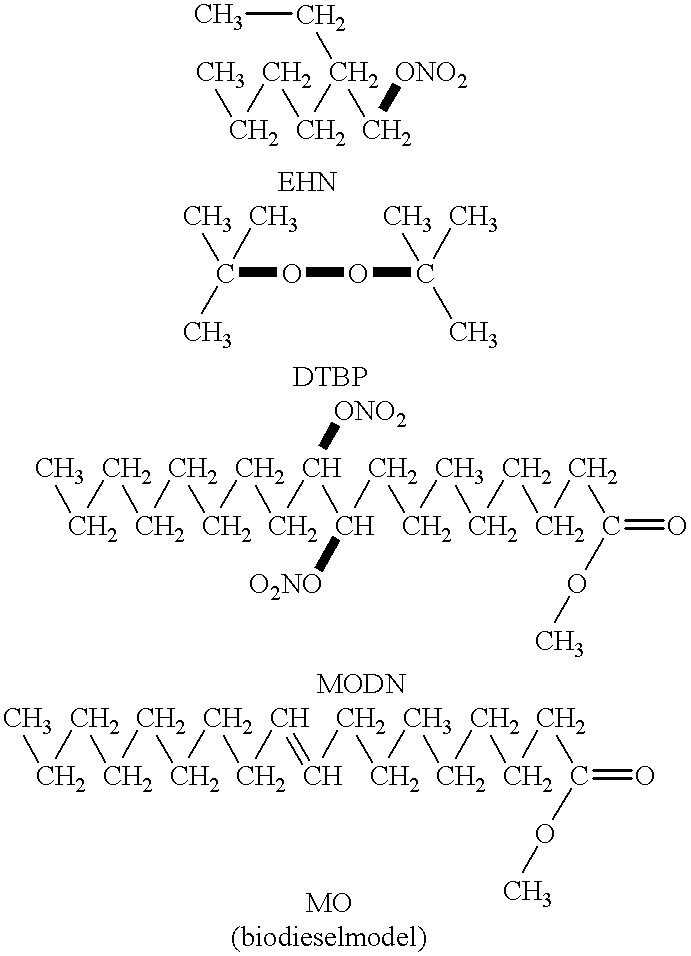Process for producing cetane improvers from triglycerides
a technology of triglyceride and improver, which is applied in the direction of organic chemistry, liquid carbonaceous fuels, fuels, etc., can solve the problems of reducing the performance limitations of long chain nitrates formed by this reaction, and the tendency of esters to reduce the effectiveness of free-radical decomposition, etc., to achieve good cetane boost, low nitrogen content, and high vapor pressure
- Summary
- Abstract
- Description
- Claims
- Application Information
AI Technical Summary
Benefits of technology
Problems solved by technology
Method used
Image
Examples
example 1
Illustrative Example 1
Preparation and Performance of Soybean Oil Nitrate
[0064] An air-free cold addition funnel was connected to a 100 ml 3-neck flask, and to a Schlenk line. The air was evacuated and the apparatus re-filled with dry N.sub.2. The cold trap on the addition funnel was then filled with dry ice. Under a nitrogen purge, 10 g of soybean oil (using an approx. MW of 880AMU this equals 1.13*10.sup.-2 moles) previously dissolved in 30 ml of CH.sub.2Cl.sub.2 was added to the flask. The flask was immersed in an ice bath, and the oil solution, brought to 0.degree. C. with constant stirring.
[0065] A capped airless addition tube was evacuated and re-filled with N.sub.2. This was then tared on a top loading balance. Next, 1.2 g of N.sub.2O (1.11*10.sup.-2 mole) was added under strong N.sub.2 purge and weighed on the same balance. The N.sub.2O.sub.5 was then added to the dropping funnel and dissolved in 50 ml of CH.sub.2Cl.sub.2. A strong flow of N.sub.2 blown through an all glass p...
example 2
Illustrative Example 2
Preparation and Performance of Oleic Acid Glycol Ester Nitrate
[0069] Using standard Schlenck techniques, an air-free cold addition funnel was connected to a 100 ml 3-neck flask. This was evacuated and re-filled with dry N.sub.2. The trap on the funnel was filled with a mixture of crushed ice and salt water. Next, an airless addition tube was evacuated, filled with N.sub.2, then weighed on a top loading balance. 4.5 g of N.sub.2O.sub.5 (0.04166 moles) was transferred to the airless addition tube and weighed. The N.sub.2O.sub.5 was transferred to a Schlenck flask and dissolved in 50 ml of cold CH.sub.2Cl.sub.2. When the powder dissolved, the solution was transferred by cannula to the air-free cold addition funnel.
[0070] 12.5 g of oleic acid glycol ester (OAEG-OH) was prepared by known esterification methods with reactants oleic acid and ethylene glycol. The OAEG-OH (0.0383 moles) was dissolved in 20 ml of CH.sub.2Cl.sub.2 and transferred to the 3-neck flask. The ...
example 3
Illustrative Example 3
Preparation and Performance of Oleic Acid Glycol Ester Nitrate
[0075] The oleic acid glycol ester nitrate of Illustrative Example 2 was prepared by dissolving 15 g of the oleic acid glycol ester with 15 g of acetic anhydride, then dropping 3.2 g of 90% HNO.sub.3 into the oil solution over a period of 3-4 hrs at room temp. NMR analysis showed this product to be similar to the product of Illustrative Example 2.
PUM
| Property | Measurement | Unit |
|---|---|---|
| Fraction | aaaaa | aaaaa |
| Fraction | aaaaa | aaaaa |
| Temperature | aaaaa | aaaaa |
Abstract
Description
Claims
Application Information
 Login to View More
Login to View More - R&D
- Intellectual Property
- Life Sciences
- Materials
- Tech Scout
- Unparalleled Data Quality
- Higher Quality Content
- 60% Fewer Hallucinations
Browse by: Latest US Patents, China's latest patents, Technical Efficacy Thesaurus, Application Domain, Technology Topic, Popular Technical Reports.
© 2025 PatSnap. All rights reserved.Legal|Privacy policy|Modern Slavery Act Transparency Statement|Sitemap|About US| Contact US: help@patsnap.com

